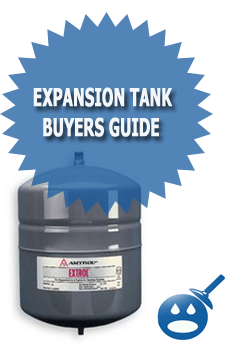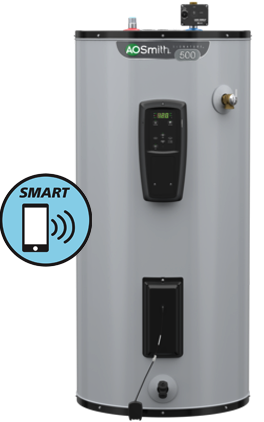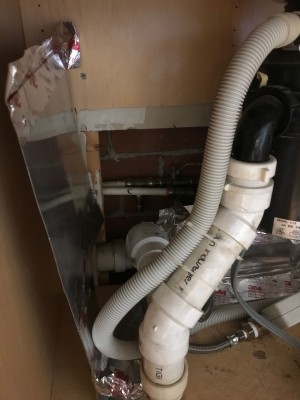Expansion Tank Buyers Guide
An expansion tank is a small tank that is used in closed water heater systems as well as domestic hot water units. The tank is designed to take in the excess water pressure that may be cause by the thermal expansion or more commonly called water hammer. The expansion tank is a small or mid size tank that is made with 2 separate sections. One side of the tank will be used for excess water and the other side is the dry side that will hold the air pressure. 
Every system has one and there may come a time when you are going to need to replace that system. There are so many brands out there but there are just a handful of companies that will offer you reliable, durable and efficient products. As a homeowner you may not know what to look for or as a professional you may be looking to comparison shop for a new brand. So we have compiled a list of Expansion Tanks to help you make an informed decision on which tanks have the features and specifications you are looking for.
Watts PLT-12 Potable Water Expansion Tank
Watts is a great company with a well-matched reputation. All of their products are efficient, compact and reliable. Watts products have great warranties and the company stands behind every product they make. The Watts PLT-12 comes with a 3/4″ male connection and a tank that hold about 4-1/2 gallons of water. The PLT Series of Expansion Tanks can be used on most heating systems such as gas, oil, electric or direct fired. Watts caters to both the professional and the residential fields. This residential water expansion tank is designed to help take in the excess volume of water that is created by thermal expansion from the system. The PLT Series can hold up against pressure that occurs throughout the water supply system. This is done by maintaining the system’s pressure by keeping below the proper T&P relief valve setting.
The Watts PLT-12 Potable Water Expansion Tank is a pre-pressurized adjustable; steel tank that is made with a polypropylene liner and a Butyl rubber diaphragm. The maximum water temperature is 160 degrees Fahrenheit with a size range of 3/4″. The Watts PLT-12 Expansion Tank’s membrane is designed to stop air to water coming to together in the tank. The strong the membrane the long life the expansion tank will be. The cost for the Watts Expansion Tank PLT-12 is about $65.00, if you shop around you could find a better deal.
Amtrol FILL-TROL 109
Amtrol has been in business for many years, they have a great reputation as well as Watts. The Amtrol FILL-TROL 109 is pre-charged at the factory and they are thoroughly tested before being shipped out. The FILL-TROL 109 system comes with a special adapted EXTROL pre pressurized expansion tank that comes set at 12 psi. All of the tanks are made from a sturdy and reliable welded steel construction. This system can be used with hot water heaters, glycol systems and heating systems. The FILL TROL 109 comes with an automatic pressure-reducing valve.
The tank is fully adjustable up to 100 psig working pressure and the company recommends installing an EXTROL into the bottom of the tank by using a 1/2″ inch nipple for the pipe and mounting connections. This style of tank is called a bladder tank. The tank’s job is to control the high and pressure made by the water expansion. The bladder tank has a moving bladder and will need a separate pressure reducing valve or a FILL TROL to keep up with the pressure of about 12 psi. The maximum temperature of the Amtrol FILL TROL 109 is about 240 degrees Fahrenheit. The maximum water pressure is 100 psi. The tank can hold about 2 gallons of water and will accept a maximum volume of .9 gallons. This tank is a lightweight tank, weighing in about 6 pounds. The price of this 2-gallon expansion tank is about $ 84.00, but if you shop around you may find a little bit of a better price.
Caleffi Solar Expansion Tank
The Solar movement is becoming more popular in recent years. They have solar panels for heating, solar panels of heating of swimming pools and now solar expansion tanks. This is onsidered to be a modern version of the solar heating system. This expansion tank can withstand temperatures of 385 degrees Fahrenheit while the tank is not being used. What happens with a solar expansion tank is that liquid vaporizes and the high temperatures in the solar circuit go to the solar stations. The pressure of the diaphragm promises that the system pressure will not exceed or fall lower than the system is designed for. The Caleffi Solar Expansion Tank comes with a welded steel body that is coated with an epoxy paint to ward off corrosion. It comes with a temperature system range of 15 degrees Fahrenheit to 250 degrees Fahrenheit. It has a maximum diaphragm temperature of 210 degrees. The working pressure allowed on the Caleffi Solar Expansion Tank is 150 psi with a factory pre-charge of 35 psi.
There are 2 different size tanks available, a 3-gallon tank and a 5-gallon tank. As the volume in the tank expands the diaphragm will stretch into the gas chamber. When this happens the space that was available for the solar fluid will increase and the pressure inside will stay the same. The price ranges on the Caleffi Solar Expansion Tanks from $58.75 to $159.75.
N-30 Wessels # 30 Expansion Tank
The Wessels N- Style Expansion Tank are non-ASME diaphragm types of tanks. They are factory pre-charged tanks that are designed for important protection of hydronic heating systems. These tanks are created for installation that will be able to take in expanded hot boiler water. At the same time, keeping the systems pressure well below the relief valve settings. The tank is a steel water reverse with a double clamped diaphragm that separates the water and the air cushion. With the design and the way this tank works it will provide a smaller tank size of about 80% than the others. The N-30 Wessels #30 Expansion Tank can hold about 2.1 gallons of water and has a system connection of about 1/2″. The tank can hold about 240 degrees Fahrenheit with a maximum working pressure of 150 psi and the tank is pre-charged with 12 PSI but a technician can adjust them.
The N-30 Wessels #30 Expansion Tank is more compact than the other expansion tanks on the market. Due to their smaller size the cost of these tanks are less than the others, the N-30 Wessels cost about $30.00. The expansion tank is needed for all hot water boiler systems. The concept of the expansion tank is to control the pressure and reduce the amount of energy being used on the heating and circulating systems. These tanks are necessary to the water heating system to hold the excess water and pressure that builds up. Without these tanks the hot water system will not run properly. These tanks are necessary and there are times when the tanks have to be replaced.
All of these tanks we profiled are cost effective and reasonably priced. Buying an expansion tank can be very confusing and very frustrating but with this buyers guide we hope to make your choice a bit easier. All of these companies that we profiled have many years in the industry and any one of these expansion tanks will make a great addition to your hot water heating system.




When reading your Expansion Tank Buyers Guide at
http://wetheadmedia.com/expansion-tank-buyers-guide/
I find the mistaken sentence :
“The tank is designed to take in the excess water pressure that may be cause by the thermal expansion or more commonly called water hammer.”
This is incorrect. Water hammer is the sudden pressure spike caused by quick closing of a valve in a pipe with flowing water and the pressure spike is caused by the momentum of water flow being suddenly stopped. This often makes an audible slamming sound throughout the piping system and is potentially damaging. It is true that thermal expansion can also cause excess pressure and is potentially very dangerous, but that is not what is meant by “water hammer” – except insofar as the term is mistakenly used and repeated through misunderstanding which is unfortunately common.
Regards,
Bill Dempster
The article is wrong! The comment is correct!
The thermal expansion is caused by water expanding as it is being heated.
Water does not compress
The expansion tank has an aircharge which will compress and it allows the expanding water to enter the tank with only a slight compression of the air charge. If the air charge wasn’t there the system pressure could go as high as 150 psi causing the T&P to discharge,
The compression of the air when the water enters may only raise the pressure a pound or, 2 since air can compress.
Water hammer is where the water is flowing at a velocity then a valve is suddenly closed bringing the flow to a sudden stop.
If you imagine the flowing water as a hammer swinging then the closing of the valve as the moment the hammer impacts, that is water hammer.
The water hammer may hit several times each one with less force similar to a hammer bouncing.
A thermal expansion tank may absorb water hammer with the air charge cushioning the effect but usually it is not in a location to do so.
Hammer arrestors should be placed just before the fast closing valve for maximum effectiveness.
Water hammer has a tremendous amount of force behind it and can be quite damaging. When I was playing fireman years ago we had a new deputy chief in our fire department and early on he was running a department drill. He had all the trucks pumping away like mad flowing huge volumes of water. Our truck alone was flowing about 2,000 GPM off a hydrant and there were at least 4 others there doing a similar amount for a total of around 8,000 GPM.
At some point the new wet behind the ears deputy chief decided to end the drill and rather than call each pumper first asking them to reduce their pressure then shut down in increments he calls over the radio, “All units shut down.” which of course each pump operator immediately did.
It was surreal as I the Captain was running towards our truck yelling, “No!”
But it was too late the every truck operator chopped the throttle and as soon as the rpm’s died down to idle closed the valves…
I arrived to see the gauge on the suction side of the pump bouncing up in the 450 psi range.
This would not have been a true indication either because the gauges are dampened by a needle valve to keep the needle from fluttering. Who knows what the actual spike reached?
Shortly after that the water companies were on the scene replacing a main that was broken in several places.
That is water hammer on a grand scale!
Surprisingly article,it is useful to me and others to know about this items,please just keep it….